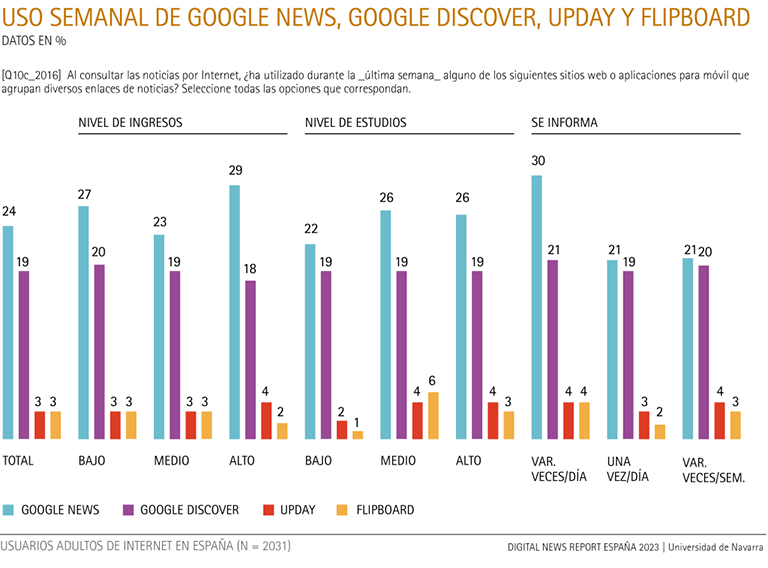-
Discover, which suggests not only topical content to Username , but also videos and other useful or interesting links, is more popular than Google News among users less interested in news.
-
Tablet news consumers use aggregators in greater proportion, and the increased integration of Discover on Android increases its popularity among users of Android devices.
The predominant aggregation services in Spain are Google News, with 24%, and Google Discover, with 19%. Upday exceeds 3% and Flipboard comes close, with a very similar figure to the average of 46 markets studied. Meanwhile, Menéame, News Republic and Feedly are at 2% each. Forty-six percent of users say they do not use any of the news aggregator options presented to them: 43% of men, 50% of women, 44% of people aged 25-54, and 51% of those over 55.

Google News has a cross-gender usage profile but is more popular among men, while in Google Discover the differences by gender are smaller but its popularity is especially notable in the 18-24 age group, with three out of ten people using it in the last week (31%), exceeding the global figure by more than half. Young people aged 18 to 24 in Spain also use Flipboard (7%) and Upday (6%) twice as much as average . In the 18-34 age group, News Republic, Feedly and Menéame also enjoy a popularity rate of 4% or more.

These news aggregation services do not show major differences by level of programs of study or income, nor by frequency of news consumption, with some exceptions: Google News is especially popular among Spanish adults with high incomes (29%) and who get information several times a day (30%).

Much more decisive is the interest in news, especially in the use of Google News. While consulting Google Discover ranges from 24% of those totally interested in information to 16% of those with little or no interest, the proportions for Google News range from 33% to 13%. In fact, among people with little or no interest in news, more use Google Discover, which offers a greater variety of content, than use Google News (three points less). In contrast, among those with a lot or all interest in news, the balance is nine points in favor of Google News, and those with a slight interest also make News more popular than Discover, by a difference of four points. Although participants are given a precise description of each service, it is difficult for respondents to distinguish one service from another when answering survey, as we noted in the previous edition, when News had not yet been launched in Spain. Upday and Flipboard also show practically twice as much use among people with a lot or all interest in news as among people with little or no interest.
The preference for one or another aggregation service is also influenced by the device used to access enquiry news on the Internet. Those who browse with the Apple iPad (36%) use Google News half as much as average of all adults connected in Spain, and this Google service also stands out among those who use an Android tablet or other operating system (29%) or an iPhone mobile (28%). Likewise, the greater integration of Google Discover on Android devices means that users of tablets (27%) and mobiles (22%) with this Google-powered platform are more likely to use this other referee, also from Google, than average.
Likewise, the use of Upday almost triples (8%) among users of Android or non-Android tablets and iPadOS and doubles compared to average among Apple iPad users (6%). Flipboard stands out especially among iPad users, tripling in popularity (9%), but also among the audience that gets its information from other tablets (7%).